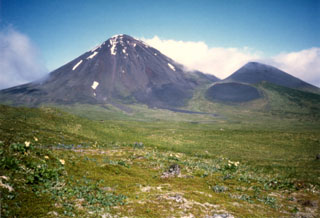Report on Semisopochnoi (United States) — 24 July-30 July 2019
Smithsonian Institution / US Geological Survey
Weekly Volcanic Activity Report, 24 July-30 July 2019
Managing Editor: Sally Sennert.
Please cite this report as:
Global Volcanism Program, 2019. Report on Semisopochnoi (United States) (Sennert, S, ed.). Weekly Volcanic Activity Report, 24 July-30 July 2019. Smithsonian Institution and US Geological Survey.
Semisopochnoi
United States
51.93°N, 179.58°E; summit elev. 1221 m
All times are local (unless otherwise noted)
On 24 July AVO reported that satellite data from the previous week indicated that the 100-m-wide crater lake in the N cone of Semisopochnoi’s Cerberus three-cone cluster was gone, and a new shallow inner crater about 80 m in diameter had formed on the crater floor. The lake had persisted since January 2019. Seismicity during 25-30 July was characterized by periods of continuous tremor, low-frequency earthquakes, and small explosion signals. Small steam plumes were visible in periodic, cloud-free satellite images, along with minor sulfur dioxide emissions.
Geological Summary. Semisopochnoi, the largest subaerial volcano of the western Aleutians, is 20 km wide at sea level and contains an 8-km-wide caldera. It formed as a result of collapse of a low-angle, dominantly basaltic volcano following the eruption of a large volume of dacitic pumice. The high point of the island is Anvil Peak, a double-peaked late-Pleistocene cone that forms much of the island's northern part. The three-peaked Mount Cerberus (renamed Mount Young in 2023) was constructed within the caldera during the Holocene. Each of the peaks contains a summit crater; lava flows on the N flank appear younger than those on the south side. Other post-caldera volcanoes include the symmetrical Sugarloaf Peak SSE of the caldera and Lakeshore Cone, a small cinder cone at the edge of Fenner Lake in the NE part of the caldera. Most documented eruptions have originated from Young, although Coats (1950) considered that both Sugarloaf and Lakeshore Cone could have been recently active.
Source: US Geological Survey Alaska Volcano Observatory (AVO)

